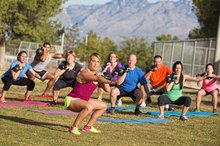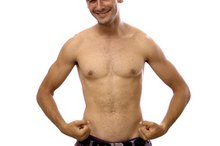How to Lose Weight Without Getting Bulky
A well-rounded weight loss program includes eating right, performing cardiovascular exercise and strengthening you body with weight training. As you lose weight, you might fear that strength training will build large, bulky muscles and make it harder for you to achieve a lean figure. Fortunately, you can perform all the necessary exercises to stay healthy and avoid getting bulky.
Reduce your daily intake of sugar, fat and calories. To lose 1 lb. of weight, you need to lose 3,500 calories. Eating 250 to 500 calories less per day. The U.S. Department of Health and Human Services states you should avoid foods with sugar in the first few ingredients and foods with more than 5 percent of the daily value of saturated fat 1.
Easiest Way to Get Rid of Love Handles
Learn More
Eat foods that fuel your body and have nutrients. According to MyPyramid.gov, you should eat mostly whole grains, a variety of vegetables, fruits, calcium-rich foods and lean protein 3. When choosing what to eat, look for foods that are low-fat and fat-free.
Participate in 30 to 60 minutes of daily aerobic exercise. Aerobic exercise burns calories to help you shed body fat and lose weight. Activities such as basketball, tennis, running, cycling, rowing and step aerobics are all examples of aerobic exercise. Vary the intensity you work at, the exercise you perform and the time you exercise to continually challenge your body.
How to Lose 10 Pounds in Three Days
Learn More
Execute low-weight and high-repetition strength training two to three times a week. Low-weight and high repetition training allows you to build muscular endurance without building new muscle tissue and getting bulky. Target each major muscle group twice a week with one to three exercises, using two to four sets of 10 to 15 repetitions for each exercise. If the exercise feels too hard, use a lighter weight.
Related Articles
References
- U.S. Department of Health and Human Services: Finding Your Way to a Healthier You
- ShapeFit: Weight Lifting Basics
- MyPyramid.gov: Steps to a Healthier You
- Piercy KL, Troiano RP, Ballard RM, et al. The physical activity guidelines for Americans. JAMA. 2018;320(19):2020-2028. doi:10.1001/jama.2018.14854
- Ho SS, Dhaliwal SS, Hills AP, Pal S. The effect of 12 weeks of aerobic, resistance or combination exercise training on cardiovascular risk factors in the overweight and obese in a randomized trial. BMC Public Health. 2012;12:704. doi:10.1186/1471-2458-12-704
- Butryn ML, Thomas JG, Lowe MR. Reductions in internal disinhibition during weight loss predict better weight loss maintenance. Obesity. 2009;17(5):1101-1103. doi:10.1038/oby.2008.646
- Black DS, O’Reilly GA, Olmstead R, Breen EC, Irwin MR. Mindfulness meditation and improvement in sleep quality and daytime impairment among older adults with sleep disturbances: A randomized clinical trial. JAMA Intern Med. 2015;175(4):494-501. doi:10.1001/jamainternmed.2014.8081
- Al Khatib HK, Hall WL, Creedon A, et al. Sleep extension is a feasible lifestyle intervention in free-living adults who are habitually short sleepers: A potential strategy for decreasing intake of free sugars? A randomized controlled pilot study. Am J Clin Nutr. 2018;107(1):43-53. doi:10.1093/ajcn/nqx030
Writer Bio
Ashley Farley has been a certified personal trainer since 2008. She is also a writer specializing in healthy living, fitness and nutrition topics. Farley has an Associate of Science in mental health services from the Community College of the Air Force and is pursuing her B.A. in English at Wright State University.









